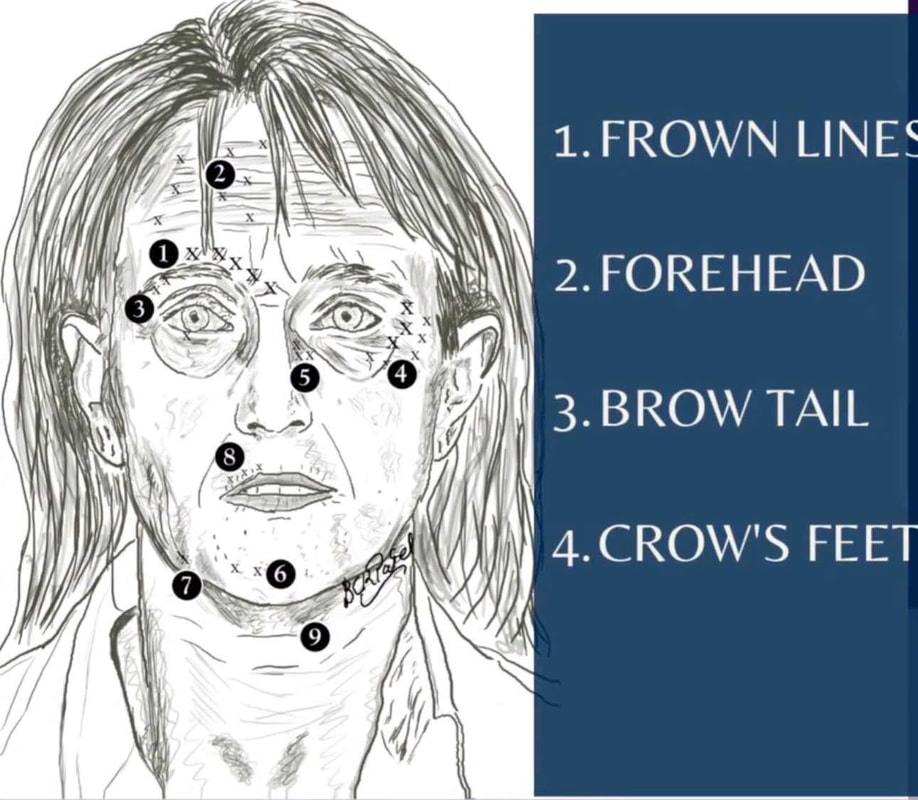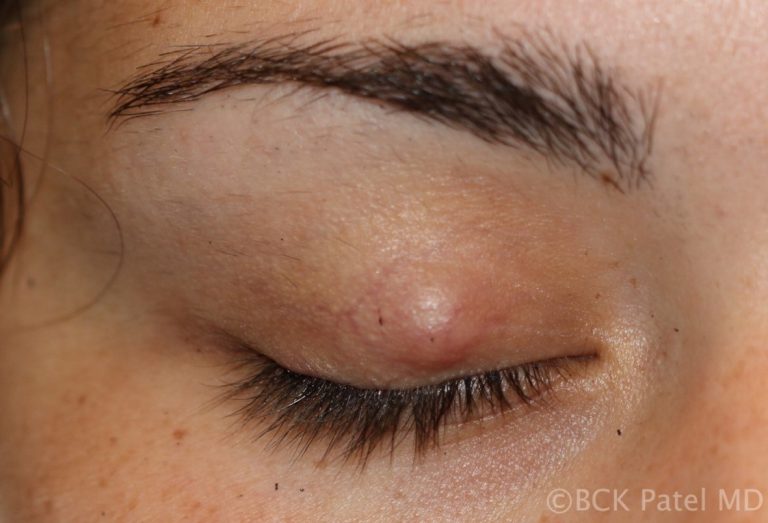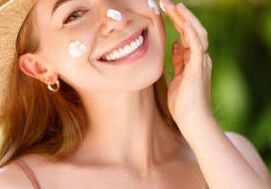Understanding Hering's Law: for residents, fellows, patientsHering’s law of equal innervation states that eye muscles or eyelid muscles of each eye are equally innervated. Therefore, in the presence of a marked ptosis on one side, the equal innervation will result in an artificially elevated opposite eyelid. If the ptotic eyelid is lifted, the opposite eyelid will usually fall because the stimulus that lifts the ptotic eyelid is lifted and the same will apply to the opposite side. Understanding Hering's law with a case exampleA 67-year-old female presents with a complaint of “my droopy left upper eyelid is interfering with my vision”. She notes that the left upper eyelid became droopy gradually over years. She has not had any intraocular surgery but has worn gas-permeable contact lenses for more than 20 years. She does not complain of any drooping of the right upper eyelid and she does not feel the right side interferes with her vision. The patient has no history of thyroid disease or any other neuromuscular diseases. There is no history of trauma. She notes that the left upper eyelid “is much worse when I am tired and at the end of the day”. Clinical examination shows a corneal reflex-eyelid margin distance of less than zero on the left side and 1 mm on the right. She has a high and poorly formed left upper eyelid skin crease with a deep superior sulcus. Her levator function is normal at more than 12 mm on both side. The right side shows a slightly raised upper eyelid skin crease which is more defined and there is early hollowing of the superior sulcus. Her left brow is higher than the right brow by 4 mm. Note the subtle prominence of the left medial fat pad which becomes revealed as the medial levator aponeurosis becomes “lateralized” with disinsertion. The orbital septum is weakest medially and this allows the medial fat pad to become more prominent. This is seen in many involutional ptosis cases. The lateralization of the levator aponeurosis also caused medial flattening of the upper eyelid as is obvious here. These are subtle signs that should be noted preoperatively and corrected surgically. The common questions a surgeon may be faced with when encountering such a patient are as follows:
Q 1. If I have a droopy eyelid on one side, should I have surgery on one side or both sides?
A 2. Absolutely. The preoperative Hering’s law test is usually predictive, but there can be a mild ptosis on the unaffected side which can become manifest after unilateral surgery. Swelling, bruising, etc after surgery will make the operated eyelid look persistently droopy for some days (even weeks) and therefore, it is important to give the body a chance to heal and the neurological responses (Hering’s in other words) to manifest themselves. We will generally not make any judgement about the final lid height for at least two months after surgery, sometimes longer. Q3. What is the best option for me? A3. How many different shades of grey are there? Horses for courses. One should not just assess the eyelids. The relationship of the eyelids to the brows (depending upon racial characteristics, sun exposure, contact lens wear, age, etc) has to be considered. Asymmetry of the face (we all have asymmetric faces) becomes slowly-but-surely more apparent as we age and this applies to the periorbital area and eyelids as well. People forget to look at the position of the lower eyelids when addressing a droopy eyelid or eyelids. We will all have one lower lid a little different (lower, fuller, etc) when compared to the other. So, after an assessment of all these factors, and with the help of a full-face photograph, options can be discussed. Q 4. When should one-sided droop of an eyelid be repaired? Should I wait until both sides droop? This is simple. If a slightly droopy eyelid does not bother you functionally or cosmetically, leave it well alone. Mild and even moderate asymmetry of the face and the eyelids is common. If you choose to have surgery on the droopy upper eyelid only, be prepared to see asymmetry after surgery with the operated side looking higher than the unoperated side. This patient underwent an anterior approach left upper eyelid ptosis repair. The orbital septum was opened and the fat released but no fat was removed. The fat was advanced to fill the deep superior sulcus and attached to the orbicularis to provide a fullness above the eyelid skin crease. The eyelid skin crease was recreated with imbrication sutures which picked up the levator aponeurosis in the eyelid skin closure Patient's appearance two months after surgery:Note the following:
references
0 Comments
For Residents, Fellows, Oncologists, Ophthalmologists, Plastic Surgeons, Dermatologists Diagnosis, Grading, Treatment, Prognosisconjunctival squamous neoplasiaSquamous cell carcinoma of the conjunctiva is at the advanced spectrum of ocular surface neoplastic disease termed "ocular surface squamous neoplasia" (OSSN).
Risk factors for OSSN:
Africa has the highest incidence of OSSN in the world because of the high levels of ultraviolet light radiation and also because of the higher incidence of HIV/AIDS. OSSN affects 1.3 out of 100,000 people per year. This is X10 higher than the incidence elsewhere in the world. In equatorial Africa, OSSN affects younger adults and proportionately more women are affected than in other parts of the world. The age of presentation in Africa is 40 years compared to 60 years in other parts of the world. In Africa, 2/3rds of the tumors are seen in females whereas 70% are males elsewhere in the world. Dr. BCK Patel MD, FRCS For patients, residents, fellows, surgeons Injection of Botox for Cosmetic ReasonsWhile there are several medical indications for botulinum toxin injection in the face and/or the neck, we are concentrating on the safe areas where judicious injection with botulinum toxin gives a pleasing result.
BCK Patel MD, FRCS For residents, fellows, plastic surgeons and oculoplastic surgeons The importance of placing temporary tarsorrhaphy sutures properlyTemporary tarsorrhaphy sutures are often needed at the end of surgical procedures on the orbit, the eyelids, after repair of facial fractures and after reconstruction of eyelids and facial structures. A tarsorrhaphy may be needed when treating or preventing the occurence of chemosis and also when one wants to protect the cornea in the postoperative period. Some of the common indications for a temporary tarsorrhaphy are:
In this video, Dr. BCK Patel MD shows the eyelid margin anatomy and show how temporary tarsorrhaphy sutures are placed at the gray line to appose the eyelids. A lateral third suture will close the lateral third, an additional central suture will generally give protection of the whole cornea. Only rarely is a third, medial suture needed. Dr. BCK Patel MD, FRCS For physicians and patients How to manage herpes zoster and its complications, with considerations for COVID-19 and the COVID vaccine. Christine Kanownik
BCK Patel MD, FRCS For Residents, Fellows, Plastic Surgeons, Oculoplastic Surgeons What is chemosis?Conjunctival chemosis is the collection of fluid under the conjunctiva, resulting in a blister-like swelling of the conjunctiva. what conditions can cause or predispose to chemosis?Photographs to be taken and sent when consulting for a facelift and neck lift and also for a Hammock liftFIRST SET OF PHOTOS IS OF YOUR FACE AND NECK AND UPPER CHEST AS SHOWN.A comprehensive review of chalazions and chalazia with a depiction of the many different faces of chalaziaDr. BCK Patel MD, FRCS
For family practice doctors, physicians, oculoplastic surgeons, ophthalmologists, residents and fellows What is a chalazion?A chalazion is initially a painless mass that develops on the eyelid. It is caused by a blockage of the Meibomian gland. The blocked gland allows the contents (lipogranulomatous material) to expand and will eventually allow the material to spread into the surrounding tissues, causing local inflammation. Initially, the chalazia are soft or rubbery but go on to become firm. Inflammation or secondary infection will lead to tenderness of the lesions. Does an initial infection of the Meibomian gland cause a chalazion to develop or is it a blocked Meibomian gland that secondarily becomes inflamed and can become infected? The exact sequence is probably both of the above in different lesions. There are many devices now available which emit light in the blue, red and infrared wavelengths. These devices may be used by medical practitioners but many home-use devices which apply the light at more conservative levels are available.
What is the CO2 laser and the fractionated CO2 laser and how do they work?definition of dennie-morgan linesOne or more creases along the lower eyelid that start at the medial canthus and progress outwards and slightly further down from the eyelid margin. There may be one or more of such lines and when they are occur in the presence of atopic dermatitis, they are called Dennie-Morgan lines.
Which parts of the face does botox work best on? |
AuthorDr. BCK Patel MD, FRCS |
- Home
- Locations
-
Conditions
- Aging Of The Face
- Aging of Lower Eyelids
- Aging of the Forehead and Brows
- Aging of Upper Eyelids
- Aging of the Cheeks
- Aging of the Neck
- Aging of the Lips
- Aging of the Mouth
- Aging of the Chin
- Aging of Eyelashes
- Aging of the Hands
- Aging Of Skin Colour
- Aging Of Hair
- Aging of the Jowls
- Aging of Men
- Aging of the Skin
- Aging of Veins and Vessels
- Scars
-
Cosmetic
- Facelift
- Browlifts
- Lower Blepharoplasty
- Upper Blepharoplasty
- Midface Lift/Hammock Lift
- Necklift
- Cosmetic Surgery for Men
- Lip Lines
- Lips
- Mouth
- Neck Liposuction
- Fat Transfer
- Skin Resurfacing
- Cheeks
- Removal of Moles, Lesions, Tags, Cysts and Blemishes
- Facial Implants
- Otoplasty, Ear Pinning, or Bat-Ear Repair
- Complications?
-
Reconstruction
- Acquired Ptosis and Dermatochalasis
- Congenital Ptosis
- Ptosis in Myasthenia Gravis
- Blepharophimosis Syndrome
- Entropion
- Ectropion
- Thyroid Eye Disease
- Nasolacrimal Duct Obstruction
- Skin Tumors
- Orbital Tumors
- Blepharospasm
- Pterygium
- Anophthalmos and Microphthalmos
- Enucleation and Evisceration
- Exenteration
- Symblepharon
- Congenital Anomalies - Lid Disorders
- Acne Rosacea
- Trauma
- Infections
-
Non Invasive
- Photorejuvenation
- Aerolase Laser
- Botox
- Radiesse
- Restylane
- Juvederm
- Fractional Carbon Dioxide CO2 Laser
- Fractional Resurfacing Lasers: Erbium lasers
- Laser Hair Removal
- Kybella
- Chemical Peels
- XEOMIN ®
- Voluma
- LATISSE EYELASH TREATMENT
- Leg Veins and Spider Vein Treatment
- Sculptra
- Neck and Chest Cosmetic Concerns
- Dysport
- Accent Radiofrequency
- Microdermabrasion and Light Chemical Peels
- Melasma
- Laser Tattoo Removal
- Color and Texture Issues – Brown Spots on Face, Redness
- Scars and Acne
- Permanent Cosmetic Makeup
- Resources
- About
- Blog
- Contact
VIDEOS
links
www.hammocklift.com
WWW.PATELFACELIFT.COM
www.englishsurgeon.com
www.drbhupendrapatel.com
bckpatel.info
WEBOFSCIENCE
researchgate
GOOGLE SCHOLAR
linktr.ee
Patel Plastic Surgery . Copyright 2024 . All Rights Reserved













